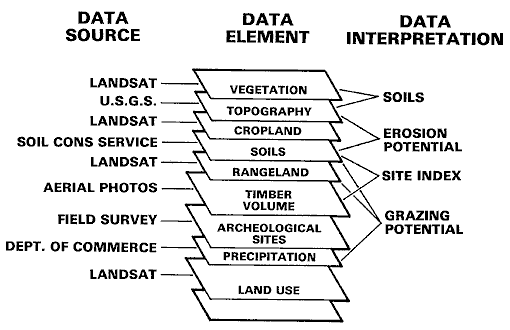

As evident from the above diagram, information from various conventional sources along with data from Landsat or similar earth-observing satellites can be singled out and often combined to produce data elements which are further convolved to produce interpretation maps and other output types that then become viable parts of environmental resource planning, site selection and other outcomes that benefit from manipulation by modeling.
Interpretative maps are derivative, i.e., they result from decisions to produce new categories stemming from combinations of several others, as, for example, a map plotting likelihood of runoff erosion which can be deduced from maps showing soil properties, topography, rainfall, stream patterns, and other related factors. Variants of this map type are allocative or suitability maps, e.g., transportation routing, evaluative maps, e.g., earthquake damage potential, and predictive maps, e.g., 100-year flood coverage.
Until the 1970s, the traditional way of using geospatial data, making decisions based on combining information sources, and applying models centered about laying out maps on a table, inspecting these individually, and mentally comparing data sets - both visual and tabular - while seeking to narrow down parts of an area to locations that were pinpointed as suitable on several defining maps was this: In principle, two or three maps treating several relevant themes could be overlaid physically by placing them on a light table (particularly if they were rephotographed as transparencies) to check on pre-selected conditions of favorability where patterns on individual maps superposed in a positive way. This is, of course, inherently cumbersome and inefficient and often the interpreter would simply glance back and forth between maps. One could also improve the interrelationship process by laying a grid over each map and extracting information according to some relative merit or weighting organized by location within the grid. The management of these data, usually in tables, nevertheless proved labor-intensive, slow, and often ineffective.
Devices were developed to allow more systematic comparisons between
maps. This could be done on a one-to-one basis by superimposing
maps and photographs through an optical projector that allowed
for differences in scale and even projection. One such device,
still in use today, is the Zoom Transfer Scope manufactured by
Bausch & Lomb.
A photo or a map is mounted at one level of the ZTS and mirrors
and lenses manipulated so that its image, projected through prisms,
appears to register in the view scope over a second map or photo
at the bottom. Tracings from the first map/photo can be drawn
on a thin sheet over the second or a photograph can be taken using
a polaroid camera within the optical train in which the two views
are merged. An illlustration of this is shown here in which a
standard road map (at 1:500,000) was initially rephotographed
so that all black or colored lines are rendered in white and then
projected through the ZTS onto a 1:1,000,000 print of a Landsat false color composite
showing Philadelphia, PA and Trenton, NJ:
But it should be obvious that this form of image combination is severely limited to normally two images (one or more additional layers are feasible if reproductions of maps or photos are displayed in other colors but multiple registration becomes difficult).
Code 935, Goddard Space Flight Center, NASA
Written by: Nicholas M. Short, Sr. email: nmshort@epix.net
and
Jon Robinson email: Jon.W.Robinson.1@gsfc.nasa.gov
Webmaster: Bill Dickinson Jr. email: rstwebmaster@gsti.com
Web Production: Christiane Robinson, Terri Ho and Nannette Fekete
Updated: 1999.03.15.